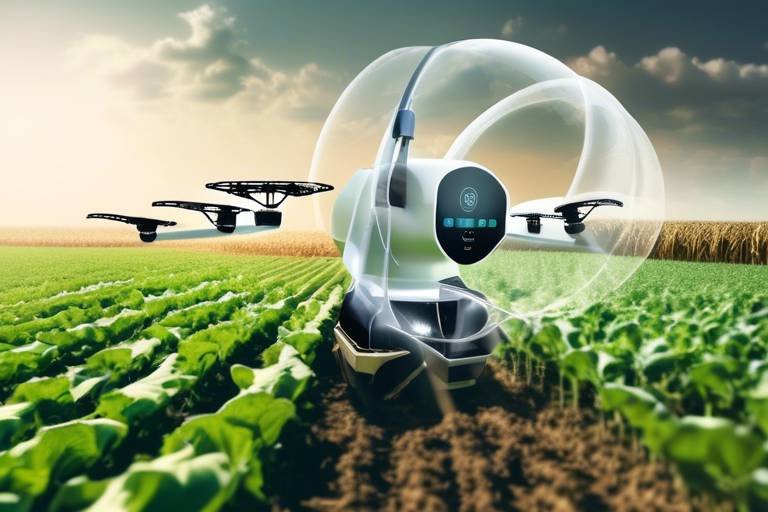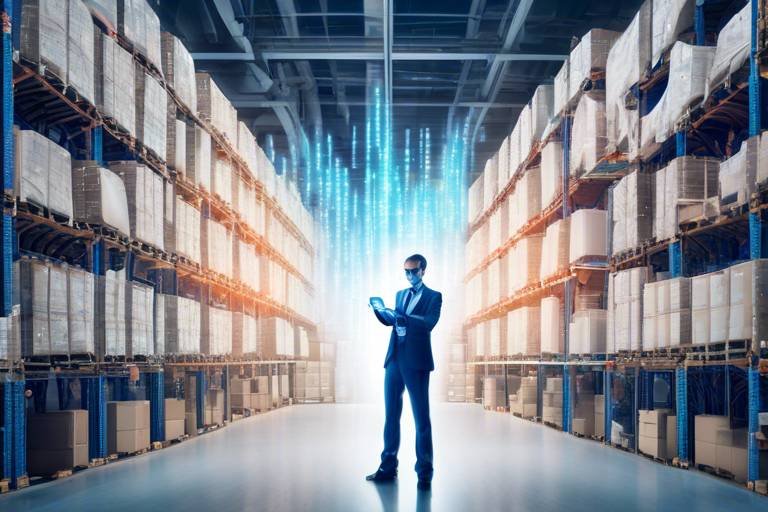The Future of Smart Agriculture Technologies
The world of agriculture is on the brink of a major transformation, driven by innovative technologies that are reshaping how we grow food and manage resources. As we face the challenges of a growing population and climate change, the need for more efficient, sustainable farming practices has never been more critical. Smart agriculture technologies are not just a trend; they represent a revolution in how we approach farming. Imagine a future where farmers can monitor their crops from the sky, make data-driven decisions in real-time, and optimize every aspect of their operations with precision. This is not science fiction; it's happening now, and it's changing the landscape of agriculture.
At the heart of this transformation is the integration of advanced technologies such as precision farming, drone technology, and the Internet of Things (IoT). These innovations empower farmers to increase productivity while minimizing their environmental footprint. For instance, precision farming utilizes data analytics to tailor farming practices to specific field conditions. This means farmers can apply the right amount of water, fertilizers, and pesticides exactly where and when they are needed, reducing waste and enhancing crop yields.
Moreover, the use of drones in agriculture is a game changer. These aerial devices provide farmers with real-time data on crop health, soil conditions, and irrigation needs. By enabling crop monitoring from above, drones allow farmers to identify potential issues early on, such as pest infestations or nutrient deficiencies. This proactive approach leads to timely interventions, ultimately improving the overall health of the crops and ensuring a more bountiful harvest.
As we delve deeper into the future of smart agriculture, it's essential to recognize the role of data collection and analysis. Drones can gather vast amounts of information about the agricultural landscape, which is then analyzed to inform farming practices. This data-driven decision-making process is crucial for optimizing operations and ensuring sustainable practices. Additionally, the cost efficiency gained through the implementation of drone technology can lead to significant savings for farmers, making it a wise investment in the long run.
The future of agriculture is not just about technology; it's also about sustainability. Smart agriculture technologies promote practices that reduce environmental impact and enhance resource conservation. For example, smart irrigation systems utilize IoT sensors to optimize water usage based on real-time conditions, ensuring that every drop counts. This not only conserves water but also promotes healthier crops that are better equipped to withstand the challenges posed by climate change.
In conclusion, the future of smart agriculture technologies is bright and full of potential. By embracing these advancements, farmers can enhance productivity, sustainability, and efficiency, paving the way for a healthier planet and a more secure food supply. The integration of precision farming, drone technology, and IoT is just the beginning of a new era in agriculture, one that promises to revolutionize how we grow food and manage our natural resources.
- What is smart agriculture? Smart agriculture refers to the use of advanced technologies such as IoT, drones, and data analytics to enhance farming practices, improve efficiency, and promote sustainability.
- How do drones benefit farmers? Drones provide real-time data on crop health, soil conditions, and irrigation needs, allowing farmers to make informed decisions and intervene early to address potential issues.
- What role does AI play in agriculture? Artificial intelligence helps analyze vast datasets to provide insights for predictive analytics, improving decision-making and streamlining farming operations.
- Are smart agriculture technologies cost-effective? Yes, while there may be initial investments, technologies like drones and smart irrigation systems can lead to significant cost savings by optimizing resource use and increasing operational efficiency.

Precision Farming
This article explores the innovative technologies transforming agriculture, enhancing productivity, sustainability, and efficiency. We'll delve into various advancements and their implications for farmers and the environment.
is not just a buzzword; it's a revolutionary approach that leverages data analytics and cutting-edge technology to optimize field-level management. Imagine being able to monitor your crops with the precision of a surgeon! This methodology maximizes crop yields while minimizing resource use, leading to more sustainable agricultural practices. By employing various tools such as GPS, sensors, and satellite imagery, farmers can gain unprecedented insights into their fields, allowing for targeted interventions that can save both time and money.
One of the key components of precision farming is the ability to collect and analyze data from multiple sources. For instance, farmers can use soil sensors to assess nutrient levels and moisture content, enabling them to apply fertilizers and water only where needed. This not only enhances the health of the crops but also significantly reduces the environmental impact. In fact, according to recent studies, precision farming can lead to a 30% reduction in water usage and a 20% decrease in fertilizer application.
Furthermore, precision farming allows for real-time monitoring of crop health. With the integration of satellite imagery and drone technology, farmers can identify issues such as pest infestations or nutrient deficiencies early on. This proactive approach enables timely interventions, improving overall crop health and yield. Picture a farmer flying a drone over their fields, spotting a patch of crops that looks a bit off, and quickly addressing the problem before it escalates. This is the future of farming!
Moreover, the economic benefits of precision farming are hard to ignore. By optimizing inputs and reducing waste, farmers can significantly improve their bottom line. A recent report highlighted that farms implementing precision agriculture techniques could see an increase in profits by up to 25%. The investment in technology may seem daunting at first, but the long-term benefits far outweigh the initial costs.
In summary, precision farming is a game-changer in the agricultural landscape. By utilizing data analytics and technology, farmers can make informed decisions that not only enhance productivity but also promote sustainability. As we move forward, the adoption of these practices will be crucial for meeting the growing global food demand while ensuring the health of our planet.
- What is precision farming?
Precision farming is an agricultural management concept that uses data analytics and technology to optimize field-level management, resulting in higher yields and reduced resource use. - How does precision farming benefit the environment?
By minimizing waste and optimizing inputs like water and fertilizers, precision farming significantly reduces the environmental impact of agriculture. - What technologies are used in precision farming?
Technologies such as GPS, soil sensors, satellite imagery, and drones are commonly used in precision farming to collect data and monitor crop health. - Can precision farming increase profits?
Yes, many farmers have reported profit increases of up to 25% after implementing precision farming techniques.

Drone Technology
Drones are not just the latest gadget for tech enthusiasts; they are revolutionizing the way we approach agriculture. Imagine soaring above vast fields, capturing stunning aerial views while simultaneously gathering critical data. This is the new reality for farmers utilizing drone technology. By providing real-time insights into crop health, soil conditions, and irrigation needs, drones are transforming traditional farming into a more dynamic, data-driven process.
One of the most exciting aspects of drone technology is its ability to enhance crop monitoring. With drones, farmers can identify potential issues early on, such as pest infestations or nutrient deficiencies. This proactive approach allows for timely interventions, which can significantly improve overall crop health and yield. Instead of waiting for visible signs of a problem, farmers can act quickly, potentially saving their crops from disaster.
Moreover, drones are equipped with advanced sensors that collect vast amounts of data. This data is not just numbers; it tells a story about the agricultural conditions of the land. Farmers can analyze this information to make informed decisions, optimizing their farming practices for better results. For instance, they can determine which areas of their fields require more attention, allowing for targeted interventions rather than a one-size-fits-all approach.
When it comes to cost efficiency, implementing drone technology can lead to significant savings. Traditional farming methods often involve extensive labor hours, but drones can reduce the need for manual labor in various tasks, such as crop scouting and monitoring. This increased operational efficiency means that farmers can allocate their resources more effectively, ultimately maximizing their profits.
Another critical aspect of drone technology is its role in soil health management. Drones can assess soil conditions, enabling farmers to implement targeted soil management practices that enhance fertility and sustainability. By understanding the specific needs of their soil, farmers can apply fertilizers and other amendments more judiciously, reducing waste and environmental impact.
In summary, drone technology is not just a trend; it’s a game-changer for the agricultural industry. By leveraging the capabilities of drones, farmers can monitor their crops more effectively, make data-driven decisions, and ultimately improve their yields while reducing costs. The future of farming is here, and it’s taking flight!
- What are the main benefits of using drones in agriculture?
Drones provide real-time data, enhance crop monitoring, improve soil health management, and increase operational efficiency, leading to higher yields and reduced costs. - How do drones collect data?
Drones are equipped with advanced sensors and cameras that capture high-resolution images and analyze various agricultural conditions. - Are drones expensive to maintain?
While there is an initial investment, the cost savings from increased efficiency and reduced labor can make drones a worthwhile investment in the long run.

Crop Monitoring
In the rapidly evolving world of agriculture, has emerged as a game-changer, thanks to the integration of drone technology. Imagine being able to survey your entire field in a matter of minutes, gathering critical data without ever stepping foot on the ground. This is not just a dream; it's the reality that modern farmers are experiencing today. Drones equipped with advanced sensors and cameras can cover vast areas, providing real-time insights into crop health, soil conditions, and even irrigation needs.
One of the most significant advantages of using drones for is the ability to identify problems before they escalate. For instance, a farmer can quickly spot areas suffering from pest infestations or nutrient deficiencies. By catching these issues early, farmers can take timely action, whether it's applying pesticides or adjusting fertilizer levels, ultimately leading to healthier crops and improved yields. This proactive approach not only saves time and resources but also minimizes the environmental impact of agricultural practices.
Moreover, drones collect a wealth of data that can be analyzed to make informed decisions. This data can include:
- Crop health assessments through NDVI (Normalized Difference Vegetation Index) mapping.
- Soil moisture levels to determine irrigation needs.
- Temperature variations across different areas of the field.
With this information, farmers can create detailed reports that help optimize their farming practices. For example, if a specific section of a field shows signs of stress, targeted interventions can be implemented rather than applying treatments uniformly across the entire field. This level of precision not only boosts productivity but also enhances sustainability by reducing excess chemical usage.
Additionally, the cost efficiency of drone technology cannot be overstated. Traditional methods of crop monitoring often involve labor-intensive processes and time-consuming manual checks. Drones streamline this by significantly reducing the number of hours spent on the ground, allowing farmers to focus on strategic decision-making rather than routine checks. The initial investment in drone technology can be quickly offset by the savings in labor and increased crop yields.
In summary, through drone technology represents a significant leap forward in agricultural practices. By leveraging aerial capabilities, farmers can make data-driven decisions that enhance productivity and sustainability. As technology continues to advance, we can expect even more innovative solutions that will empower farmers to meet the challenges of modern agriculture head-on.
Q: How do drones improve crop monitoring?
A: Drones provide real-time data on crop health, soil conditions, and irrigation needs, allowing farmers to identify issues early and make informed decisions.
Q: What type of data can drones collect?
A: Drones can collect data on crop health, soil moisture levels, temperature variations, and more, which can be analyzed for better farming practices.
Q: Are drones cost-effective for farmers?
A: Yes, while there is an initial investment, drones can lead to significant cost savings by reducing labor hours and increasing operational efficiency.

Data Collection
In the realm of smart agriculture, the significance of data collection cannot be overstated. Drones have emerged as pivotal tools in this process, offering farmers a bird's-eye view of their fields and enabling them to gather critical information that was previously challenging to obtain. Imagine having the ability to monitor your entire farm from the sky, pinpointing areas that need attention with just a few clicks. This is not just a dream; it’s the new reality.
With the integration of drone technology, farmers can collect a variety of data types, including:
- Crop health assessments: Drones equipped with advanced sensors can analyze plant health using multispectral imaging, identifying stressed crops that may require immediate intervention.
- Soil moisture levels: By assessing moisture content in different areas, farmers can optimize irrigation practices, ensuring that water is used efficiently.
- Pest and disease detection: Early identification of pest infestations or diseases allows for timely action, reducing the potential for crop loss.
This data is not just numbers; it tells a story of the farm's health. By compiling and analyzing this information, farmers can make informed decisions that lead to better yields and lower costs. The data collected can be visualized in various ways, such as through heat maps or 3D models, making it easier to understand the overall condition of the fields.
Furthermore, the integration of this data into farm management systems enhances the decision-making process. For instance, a farmer can compare data from different seasons to identify trends, such as which crops performed best under certain conditions. This level of insight is invaluable, as it allows farmers to adapt their strategies to maximize productivity and sustainability.
The potential for drone data collection in agriculture is immense. As technology continues to evolve, we can expect even more sophisticated tools that will provide deeper insights into farming practices. The future of agriculture is not just about planting and harvesting; it’s about leveraging data to cultivate a more efficient and sustainable food system.
- How do drones collect data in agriculture?
Drones collect data using various sensors, including multispectral and thermal cameras, which analyze crop health, soil conditions, and other vital metrics. - What are the benefits of using drones for data collection?
Drones provide real-time data, reduce the time and labor needed for traditional monitoring methods, and enhance decision-making through detailed analysis. - Can drone data be integrated with other farming technologies?
Yes, the data collected by drones can be integrated with farm management software, allowing for comprehensive analysis and improved operational efficiency.

Cost Efficiency
Implementing drone technology in agriculture is not just a trend; it's a game-changer that brings significant cost savings to farmers. Imagine this: you’re a farmer managing hundreds of acres. The traditional methods of monitoring crops can be labor-intensive and time-consuming. Drones swoop in like modern-day superheroes, allowing you to cover vast areas in a fraction of the time. This not only reduces the hours spent in the field but also minimizes the need for excessive manpower.
One of the most compelling aspects of using drones is their ability to gather real-time data. This data can pinpoint areas that require attention, whether it’s a section of crops that needs more water or a patch that’s suffering from pest infestations. By addressing these issues promptly, farmers can avoid larger problems down the line, which often come with hefty costs. For instance, early detection of pest issues can prevent the need for widespread pesticide application, which is not only expensive but also harmful to the environment.
Furthermore, the initial investment in drone technology can be offset by the savings in other areas. Here’s a breakdown of potential savings:
| Cost Factor | Traditional Method | With Drones | Estimated Savings |
|---|---|---|---|
| Labor Costs | $50/hour | $20/hour | 60% |
| Monitoring Time | 20 hours/week | 5 hours/week | 75% |
| Pesticide Use | $200/week | $50/week | 75% |
As you can see from the table, the shift to drone technology can lead to substantial reductions in labor and operational costs. This means that farmers can allocate their resources more effectively, investing in other areas of their operations, such as improving crop varieties or enhancing soil health.
Moreover, the longevity of drones also plays a role in cost efficiency. With proper maintenance, drones can serve farmers for several years, making them a long-term asset rather than a fleeting expense. The combination of reduced labor costs, timely interventions, and the ability to make data-driven decisions creates a virtuous cycle of savings and increased productivity.
In conclusion, the achieved through the use of drones is undeniable. By harnessing this technology, farmers not only enhance their operational efficiency but also pave the way for a more sustainable and profitable future in agriculture.
- How much do drones cost for agricultural use?
Drones can range from a few hundred to several thousand dollars, depending on the technology and features. - Are drones easy to operate?
Yes, many drones come with user-friendly interfaces and automated features that simplify operation. - Can drones help with livestock management?
Absolutely! Drones can monitor livestock locations and health, aiding in overall farm management. - What are the legal requirements for using drones in agriculture?
Farmers must comply with local regulations, which may include obtaining licenses and following safety guidelines.

Soil Health Management
Soil health management is a critical aspect of modern agriculture, and it has gained significant attention in recent years due to its profound impact on crop productivity and environmental sustainability. With the advent of drone technology, farmers can now assess soil conditions more accurately than ever before. Drones equipped with advanced sensors and imaging capabilities provide real-time data on soil health, allowing farmers to make informed decisions about their land management practices.
By utilizing drones for soil health assessment, farmers can identify various factors that affect soil quality, such as nutrient levels, moisture content, and compaction. This information is invaluable, as it enables farmers to implement targeted soil management strategies that enhance fertility and sustainability. For instance, if a drone reveals that a specific area of a field is deficient in nitrogen, the farmer can apply fertilizers precisely where needed, rather than treating the entire field uniformly. This not only saves costs but also minimizes the environmental impact by reducing excess fertilizer runoff into nearby waterways.
Furthermore, soil health management through drone technology promotes a proactive approach to farming. Instead of waiting for visible signs of nutrient deficiencies or other soil-related issues, farmers can monitor their fields continuously. This ongoing surveillance allows for timely interventions, which can significantly improve crop yields and soil conditions over time.
To better understand the benefits of soil health management, consider the following key aspects:
- Enhanced Fertility: Regular monitoring helps maintain optimal soil conditions, leading to healthier plants and increased yields.
- Resource Efficiency: Targeted applications of fertilizers and amendments reduce waste and lower costs.
- Environmental Protection: Improved soil health minimizes erosion and nutrient runoff, protecting surrounding ecosystems.
- Long-term Sustainability: Healthy soils contribute to the resilience of agricultural systems against climate change and other challenges.
In conclusion, effective soil health management is vital for sustainable agriculture. By leveraging drone technology, farmers can gain deeper insights into their soil conditions, leading to better decision-making and enhanced productivity. As we look to the future, it is clear that innovations in soil health management will play a crucial role in ensuring food security and environmental conservation.
Q1: How can drones improve soil health management?
A1: Drones provide real-time data on soil conditions, allowing farmers to identify nutrient deficiencies and other issues early on. This enables targeted interventions that enhance soil fertility and sustainability.
Q2: What are the benefits of maintaining healthy soil?
A2: Healthy soil leads to better crop yields, reduced erosion, improved water retention, and lower reliance on chemical fertilizers. It also supports a more sustainable farming practice.
Q3: How often should soil health be monitored?
A3: Regular monitoring is recommended, especially during critical growth periods. Using drones allows for continuous surveillance, making it easier to track changes in soil health over time.

IoT in Agriculture
This article explores the innovative technologies transforming agriculture, enhancing productivity, sustainability, and efficiency. We'll delve into various advancements and their implications for farmers and the environment.
Precision farming utilizes data analytics and technology to optimize field-level management. This approach maximizes crop yields while minimizing resource use, leading to more sustainable agricultural practices.
Drones are revolutionizing agriculture by providing real-time data on crop health, soil conditions, and irrigation needs. Their aerial capabilities enhance monitoring and decision-making for farmers.
Using drones for crop monitoring enables farmers to identify issues early, such as pest infestations or nutrient deficiencies. This proactive approach helps in timely interventions, improving overall crop health.
Drones collect vast amounts of data, allowing for detailed analysis of agricultural conditions. This information is crucial for making informed decisions and optimizing farming practices.
Implementing drone technology can lead to significant cost savings by reducing labor hours and increasing operational efficiency, making it a valuable investment for modern farms.
Drones also play a crucial role in assessing soil health, enabling farmers to implement targeted soil management practices that enhance fertility and sustainability.
The Internet of Things (IoT) connects devices and sensors in agriculture, facilitating real-time monitoring and automation of various farming processes. This interconnectedness enhances efficiency and data-driven decision-making. Imagine a farm where every aspect, from soil moisture to livestock health, is monitored continuously, providing farmers with invaluable insights at their fingertips.
With IoT, farmers can utilize smart irrigation systems that adjust watering schedules based on weather forecasts and soil moisture levels. This not only conserves water but also ensures that crops receive the right amount of hydration at the right time. Additionally, IoT devices can monitor livestock, providing real-time data on their health and behavior, which helps farmers improve animal welfare and productivity.
Smart irrigation systems utilize IoT sensors to optimize water usage based on soil moisture levels, weather conditions, and crop needs. These systems can significantly reduce water waste and ensure that crops are adequately watered, leading to healthier plants and higher yields. For instance, a study showed that farms using smart irrigation can save up to 30% more water compared to traditional methods.
IoT devices enable farmers to monitor livestock health and behavior, improving animal welfare and productivity while reducing disease transmission and management costs. By employing wearable technology for livestock, farmers can track vital signs and activities, allowing for early detection of health issues. This proactive approach not only enhances productivity but also contributes to better animal care.
Artificial intelligence (AI) is transforming agriculture by enabling predictive analytics and automation. AI algorithms analyze vast datasets to provide insights, improving decision-making and operational efficiency.
AI-driven predictive analytics help farmers anticipate crop yields, pest outbreaks, and market trends, allowing for better planning and resource allocation.
Automation technologies powered by AI streamline various farming processes, from planting to harvesting, reducing labor costs and increasing productivity.
Smart agriculture technologies promote sustainable practices that reduce environmental impact. These innovations help farmers balance productivity with ecological responsibility, ensuring a healthier planet for future generations.
Technologies such as precision farming and smart irrigation contribute to resource conservation by minimizing waste and optimizing inputs, leading to more sustainable agricultural practices.
Innovative agricultural technologies enhance resilience to climate change by improving crop adaptability and resource management, ensuring food security in an uncertain future.
- What is IoT in agriculture? IoT in agriculture refers to the use of connected devices and sensors that facilitate real-time monitoring and automation of farming processes.
- How does smart irrigation work? Smart irrigation systems use IoT sensors to optimize water usage based on soil moisture levels and weather conditions.
- What are the benefits of using drones in agriculture? Drones provide real-time data on crop health, enhance monitoring capabilities, and improve decision-making processes for farmers.
- How can AI contribute to farming? AI can analyze large datasets to provide insights, enhance predictive analytics, and automate various farming processes, increasing efficiency and productivity.

Smart Irrigation Systems
In the world of agriculture, water is life. Yet, with the rising concerns over water scarcity and the need for efficient resource management, traditional irrigation methods are becoming increasingly inadequate. Enter , a revolutionary approach that leverages technology to ensure that crops receive the precise amount of water they need, when they need it. These systems utilize a combination of sensors, weather data, and automated controls to optimize water usage, significantly enhancing both crop health and sustainability.
Imagine walking through a lush green field, where every plant is thriving, not because of excessive watering, but due to an intelligent system that knows exactly what each crop requires. Smart irrigation systems are designed to monitor soil moisture levels, weather conditions, and even the specific needs of different crops. This means that rather than applying a blanket approach to watering, farmers can tailor their irrigation practices to meet the unique demands of their fields. For instance, a tomato plant may require different moisture levels compared to corn, and smart systems can adjust accordingly.
One of the key components of smart irrigation systems is the use of IoT sensors. These sensors are strategically placed in the soil to measure moisture content and relay that information back to a central system. When the soil is adequately moist, the system can delay watering, conserving water and reducing costs. Conversely, during dry spells, the system can trigger irrigation to ensure crops remain healthy. This real-time data collection and analysis are game-changers for modern farming.
| Benefits of Smart Irrigation Systems | Description |
|---|---|
| Water Conservation | Reduces water waste by applying the right amount of water at the right time. |
| Cost Efficiency | Decreases water bills and labor costs associated with manual irrigation. |
| Improved Crop Health | Ensures crops receive optimal moisture levels, enhancing growth and yield. |
| Data-Driven Decisions | Provides farmers with actionable insights based on real-time data. |
Moreover, smart irrigation systems can be integrated with weather forecasting tools, allowing farmers to anticipate rainfall and adjust their irrigation schedules accordingly. This proactive approach not only saves water but also helps in maintaining soil health and preventing issues like erosion and runoff. Think of it as having a personal weather assistant that ensures your crops are always in the best condition possible.
In conclusion, the adoption of smart irrigation systems represents a significant leap towards sustainable agriculture. By embracing these technologies, farmers can not only enhance their productivity but also contribute to the conservation of precious water resources. As we look towards the future, it's clear that smart irrigation is not just a trend; it's a necessity for a thriving agricultural sector in a world facing environmental challenges.
- What is a smart irrigation system?
A smart irrigation system uses technology to monitor soil moisture and weather conditions, optimizing water usage for crops. - How does it save water?
By applying water only when necessary, based on real-time data, reducing waste and improving efficiency. - Can smart irrigation systems be integrated with other technologies?
Yes, they can work alongside IoT devices, weather forecasting tools, and even drones for comprehensive farm management. - Are smart irrigation systems expensive to install?
While there may be upfront costs, the long-term savings on water and labor often outweigh these initial investments.

Livestock Monitoring
In today's fast-paced agricultural landscape, has emerged as a game-changer, thanks to the integration of Internet of Things (IoT) technologies. Imagine being able to keep an eye on your livestock from anywhere in the world, just like checking your smartphone for messages. This level of connectivity not only enhances animal welfare but also boosts productivity and profitability on the farm. With IoT devices, farmers can monitor various parameters, such as health, behavior, and location, in real-time, ensuring that every animal is thriving.
One of the most significant advantages of livestock monitoring systems is the ability to track the health of animals continuously. For instance, wearable sensors can provide data on vital signs, activity levels, and even stress indicators. This data allows farmers to detect early signs of illness or distress, enabling timely interventions that can save lives and reduce veterinary costs. It's like having a personal health assistant for each animal, ensuring they get the care they need when they need it.
Moreover, these monitoring systems can help in managing feeding schedules and optimizing nutrition. By analyzing the feeding patterns and weight gain of livestock, farmers can adjust rations and ensure that each animal receives the right nutrients for optimal growth. This not only improves the health of the livestock but also contributes to better meat and milk production. Think of it as a personalized diet plan tailored for each animal, maximizing their potential.
Another exciting aspect of livestock monitoring is the ability to enhance biosecurity measures. By using GPS tracking, farmers can keep tabs on the location of their animals, preventing unauthorized access and ensuring that livestock remains safe from potential diseases. This proactive approach is crucial in maintaining a healthy herd and protecting investments.
To illustrate the impact of livestock monitoring, consider the following table that outlines some key benefits:
| Benefit | Description |
|---|---|
| Health Monitoring | Real-time tracking of vital signs and activity levels to detect health issues early. |
| Feeding Optimization | Adjusting rations based on individual animal needs to improve growth and production. |
| Biosecurity | GPS tracking to prevent unauthorized access and protect livestock from diseases. |
| Data Analytics | Utilizing collected data for better decision-making and resource allocation. |
In conclusion, livestock monitoring is not just a trend; it's a necessity in modern farming. By leveraging IoT technology, farmers can ensure the health and productivity of their livestock while also making informed decisions that lead to better management practices. This level of oversight and control represents a significant leap forward in agricultural practices, paving the way for a more sustainable and efficient future.
- What is livestock monitoring? Livestock monitoring refers to the use of technology, such as IoT devices, to track the health, behavior, and location of farm animals in real-time.
- How does livestock monitoring benefit farmers? It enables early detection of health issues, optimizes feeding practices, enhances biosecurity, and improves overall productivity.
- What types of devices are used for livestock monitoring? Common devices include wearable sensors, GPS trackers, and health monitoring systems that collect and analyze data.
- Can livestock monitoring help in reducing costs? Yes, by preventing diseases and optimizing feed, farmers can significantly reduce veterinary and operational costs.

Artificial Intelligence
Artificial Intelligence (AI) is not just a buzzword; it's a game-changer in the agricultural landscape. Imagine having a virtual assistant that can analyze data faster than you can say "crop rotation." With AI, farmers are empowered to make decisions based on predictive analytics, which can significantly enhance productivity and operational efficiency. But how does it work? Well, AI algorithms can process vast amounts of data, identifying patterns and trends that humans might overlook. This capability is akin to having a crystal ball that predicts not just the weather but also crop yields and market trends.
One of the most exciting applications of AI in agriculture is in predictive analytics. This technology allows farmers to anticipate various factors such as crop yields, pest outbreaks, and even market fluctuations. By analyzing historical data and current conditions, AI can provide insights that help farmers plan better. For instance, consider a farmer who uses AI to analyze weather patterns and soil conditions. With this information, they can decide the optimal time to plant their crops, ultimately leading to higher yields and reduced waste. It’s like having a weather forecaster, market analyst, and agronomist rolled into one!
Moreover, AI is revolutionizing the way we approach automation in farming. From planting to harvesting, automation technologies powered by AI streamline various processes. This not only reduces labor costs but also increases productivity. Imagine a farm where tractors are autonomously navigating fields, planting seeds with pinpoint accuracy, and even harvesting crops when they reach peak ripeness. This level of efficiency can drastically transform the agricultural sector, making it more competitive and sustainable.
To give you a clearer picture of how AI impacts agriculture, let’s look at a few key areas:
| AI Application | Benefits |
|---|---|
| Predictive Analytics | Anticipates crop yields, pest outbreaks, and market trends. |
| Automation | Reduces labor costs and increases productivity through autonomous machinery. |
| Data Analysis | Identifies patterns in soil health and crop performance for better decision-making. |
But with great power comes great responsibility. As AI continues to evolve, it’s crucial for farmers to stay informed about the ethical implications and potential challenges that may arise. Issues such as data privacy, job displacement, and the digital divide between tech-savvy farmers and those who may struggle to adapt are all important considerations. The future of agriculture will rely not only on technological advancements but also on how we navigate these challenges.
In conclusion, the integration of into agriculture is paving the way for a more efficient and sustainable future. By leveraging the power of AI, farmers can optimize their operations, reduce waste, and ultimately feed a growing global population. So, the next time you bite into a juicy apple or savor a fresh vegetable, remember that AI might just be behind the scenes, ensuring that what you eat is not only delicious but also produced in the most efficient way possible.
Q: How is AI used in agriculture?
A: AI is used in agriculture for predictive analytics, automation of farming processes, and data analysis to enhance decision-making and improve crop yields.
Q: What are the benefits of using AI in farming?
A: The benefits include increased productivity, reduced labor costs, better resource management, and improved crop health through data-driven insights.
Q: Are there any challenges associated with AI in agriculture?
A: Yes, challenges include data privacy concerns, potential job displacement, and the need for farmers to adapt to new technologies.

Predictive Analytics
is a game-changer in the world of agriculture, bringing a new level of intelligence to farming practices. Imagine having the ability to foresee potential challenges before they even arise—this is precisely what predictive analytics offers to farmers. By leveraging artificial intelligence and vast datasets, farmers can make informed decisions that significantly enhance their productivity and efficiency.
At its core, predictive analytics utilizes historical data, statistical algorithms, and machine learning techniques to identify the likelihood of future outcomes based on past events. For instance, farmers can analyze weather patterns, soil conditions, and crop performance data to predict crop yields for the upcoming season. This foresight allows them to plan their resources effectively, ensuring that they are well-prepared for any challenges that may come their way.
One of the most impressive aspects of predictive analytics is its ability to provide insights into pest outbreaks. By examining data trends, farmers can identify conditions that may lead to infestations, allowing them to take preventive measures before pests cause significant damage. This proactive approach not only saves crops but also reduces the need for chemical interventions, promoting a more sustainable farming practice.
To illustrate the impact of predictive analytics, consider the following table that highlights the potential benefits:
| Benefit | Description |
|---|---|
| Improved Decision-Making | Farmers can make data-driven decisions that enhance productivity and resource management. |
| Increased Efficiency | By anticipating needs, farmers can optimize their operations, reducing waste and costs. |
| Enhanced Yield Forecasting | Predictive models help in estimating crop yields accurately, aiding in better planning. |
| Pest Management | Early detection of potential pest issues allows for timely interventions, minimizing damage. |
Moreover, predictive analytics can extend beyond crop management. For instance, it can also be applied to market trends. By analyzing consumer behavior and market demands, farmers can adjust their production strategies accordingly, ensuring that they are not only growing the right crops but also maximizing their profits. This ability to align production with market needs is crucial in today’s ever-changing agricultural landscape.
In conclusion, embracing predictive analytics is like having a crystal ball for farmers. It empowers them to not just react to challenges but to anticipate and prepare for them. As technology continues to evolve, the role of predictive analytics in agriculture will only grow, paving the way for smarter, more efficient, and sustainable farming practices.
- What is predictive analytics in agriculture?
Predictive analytics in agriculture involves using historical data and statistical algorithms to forecast future outcomes, helping farmers make informed decisions. - How can predictive analytics improve crop yields?
By analyzing data on weather, soil conditions, and past crop performance, farmers can anticipate yields and optimize their farming practices accordingly. - Is predictive analytics costly to implement?
While there may be initial costs for technology and data analysis, the long-term benefits in efficiency and productivity often outweigh these costs.

Automation in Farming
When we think about the future of farming, the word automation often comes to mind. Imagine a world where tractors drive themselves, drones monitor crops without human intervention, and data analytics predict the best time to plant seeds. This is not just a dream; it’s happening right now! Automation in farming is revolutionizing the agricultural landscape, making it more efficient and productive than ever before.
At the heart of this transformation are advanced technologies that streamline various farming processes. For instance, autonomous tractors can plow fields, plant seeds, and even harvest crops with minimal human oversight. These machines are equipped with GPS and sensors that enable them to navigate fields accurately, ensuring that every inch of land is utilized effectively. This level of precision not only saves time but also reduces fuel consumption, making it a win-win situation for farmers.
But let’s not stop there! Automation also extends to data management. Farmers can now use software platforms that integrate data from multiple sources, including weather forecasts, soil conditions, and crop health reports. This data-driven approach allows farmers to make informed decisions quickly. For example, if a sudden drought is forecasted, farmers can adjust their irrigation schedules proactively, ensuring their crops receive the water they need without wasting resources.
The benefits of automation in farming are numerous:
- Increased Efficiency: Automated systems can operate around the clock, performing tasks that traditionally required human labor. This leads to faster operations and higher productivity.
- Cost Savings: With fewer labor hours needed, farmers can save significantly on operational costs. Additionally, precision technologies reduce the waste of inputs like seeds, fertilizers, and pesticides.
- Improved Crop Management: Automation allows for real-time monitoring and adjustments, leading to healthier crops and better yields.
Moreover, automation is not just about machinery; it also includes smart farming technologies that utilize sensors and IoT devices. These tools can monitor everything from soil moisture levels to crop health, sending alerts to farmers when intervention is needed. This means that farmers can react swiftly to issues, whether it’s a pest outbreak or a nutrient deficiency, ensuring their crops thrive.
As we look to the future, the adoption of automation in farming is expected to grow. Farmers who embrace these technologies will not only enhance their productivity but also contribute to a more sustainable agricultural system. With the world’s population projected to reach nearly 10 billion by 2050, the need for efficient food production is more critical than ever. Automation in farming is not just a trend; it’s a necessary evolution that will help us meet the challenges of tomorrow.
- What is automation in farming?
Automation in farming refers to the use of technology to perform agricultural tasks with minimal human intervention, enhancing efficiency and productivity. - How does automation improve crop yields?
By utilizing data analytics and machine learning, automated systems can optimize planting, watering, and harvesting schedules, leading to healthier crops and better yields. - Are automated farming technologies expensive?
While the initial investment can be high, the long-term cost savings and increased productivity often outweigh these expenses, making automation a worthwhile investment. - Can small farms benefit from automation?
Absolutely! Many automation technologies are scalable and can be adapted to suit the needs of small farms, helping them compete in a rapidly changing agricultural landscape.

Sustainable Practices
In today's world, where environmental concerns are at the forefront of global discussions, in agriculture have become more crucial than ever. The integration of smart agriculture technologies not only enhances productivity but also promotes a more responsible approach to farming. Imagine a world where farmers can grow more food while using fewer resources and causing less harm to the planet. This is not just a dream; it is becoming a reality through innovative practices that prioritize sustainability.
One of the key aspects of sustainable agriculture is resource conservation. Technologies such as precision farming and smart irrigation systems are designed to minimize waste and optimize inputs. For instance, precision farming utilizes data analytics to determine the exact amount of water, fertilizers, and pesticides required for specific crop areas. This targeted approach not only boosts crop yields but also reduces the overuse of resources, leading to a healthier ecosystem.
Additionally, smart irrigation systems, equipped with IoT sensors, monitor soil moisture levels and weather conditions in real-time. By adjusting water usage based on actual crop needs, these systems ensure that water is conserved efficiently. This is especially vital in regions facing water scarcity, where every drop counts. The result? Healthier crops and a more sustainable approach to one of our most precious resources: water.
Moreover, climate resilience is another significant benefit of adopting smart agriculture technologies. With climate change posing a serious threat to food security, farmers must adapt to shifting weather patterns and extreme conditions. Innovative agricultural technologies enable farmers to improve crop adaptability through better resource management. For example, data-driven insights allow farmers to select crop varieties that are more resistant to drought or pests, ensuring that they can maintain productivity even in challenging climates.
As we delve deeper into sustainable practices, it's essential to recognize the role of cover cropping and crop rotation. These traditional methods, when combined with modern technologies, create a powerful synergy. Cover crops, for instance, improve soil health by preventing erosion and enhancing nutrient content. When farmers rotate crops, they naturally disrupt pest cycles and reduce the need for chemical interventions. This holistic approach not only benefits the soil but also enhances biodiversity, creating a thriving ecosystem.
To illustrate the impact of sustainable practices, consider the following table that highlights the benefits of integrating smart technologies in agriculture:
| Technology | Benefit |
|---|---|
| Precision Farming | Optimizes resource use, increases yields |
| Smart Irrigation | Conserves water, promotes healthier crops |
| Drones for Monitoring | Identifies crop issues early, reduces waste |
| AI in Crop Management | Enhances decision-making, improves efficiency |
In conclusion, sustainable practices in agriculture are not just about reducing environmental impact; they are about creating a balanced ecosystem that benefits both farmers and the planet. By embracing innovative technologies and traditional methods, we can ensure that agriculture remains productive and sustainable for generations to come. The future of farming lies in our ability to adapt and innovate, and the path forward is paved with sustainable practices that respect our natural resources.
- What are sustainable agricultural practices? Sustainable agricultural practices are methods that promote farming that is environmentally friendly, economically viable, and socially responsible.
- How do smart technologies contribute to sustainability in agriculture? Smart technologies optimize resource use, enhance crop management, and improve overall efficiency, leading to reduced environmental impact.
- Why is climate resilience important in agriculture? Climate resilience helps farmers adapt to changing weather patterns and extreme conditions, ensuring food security and stable production.
- Can traditional farming methods be integrated with modern technology? Yes, combining traditional methods such as crop rotation and cover cropping with modern technologies creates a synergistic effect that enhances sustainability.

Resource Conservation
In the realm of modern agriculture, has emerged as a pivotal focus, driven by the urgent need to sustain our planet's resources while maximizing agricultural output. With the advent of smart technologies, farmers are now equipped with tools that not only enhance productivity but also minimize waste. This dual benefit is crucial, especially when we consider the increasing pressures of climate change and a growing global population.
One of the most significant advancements in resource conservation is the implementation of precision farming. This innovative approach leverages data analytics to ensure that every resource—be it water, fertilizers, or pesticides—is used judiciously. By analyzing data from various sources, farmers can make informed decisions about when and how much to apply, leading to a significant reduction in excess usage. For example, precision farming can decrease water usage by up to 30%, which is a game-changer in regions facing water scarcity.
Moreover, smart irrigation systems play a crucial role in conserving water. These systems utilize IoT sensors that monitor soil moisture levels and weather conditions in real-time. This means that irrigation can be adjusted automatically, ensuring that crops receive the optimal amount of water without waste. Imagine a farmer who can control their irrigation system from their smartphone, receiving alerts when the soil moisture drops below a certain level. This not only conserves water but also promotes healthier crops, leading to better yields.
Another aspect of resource conservation is the careful management of nutrient inputs. Traditional farming methods often lead to over-fertilization, which can harm the environment through runoff and soil degradation. However, with the help of advanced technologies, farmers can now conduct soil health assessments using drones. These drones collect data on nutrient levels and soil composition, allowing for targeted application of fertilizers. This method not only conserves resources but also enhances soil health, creating a more sustainable farming ecosystem.
To further illustrate the impact of these technologies, consider the following table that highlights the benefits of various resource conservation practices:
| Practice | Benefits | Impact on Resources |
|---|---|---|
| Precision Farming | Maximizes yields, minimizes waste | Reduces water and fertilizer usage |
| Smart Irrigation | Optimizes water usage | Conserves water resources |
| Soil Health Management | Enhances soil fertility | Reduces chemical runoff |
Ultimately, the integration of smart agriculture technologies into farming practices not only promotes resource conservation but also ensures that farmers can produce food sustainably. This is vital for maintaining ecological balance and securing food supplies for future generations. By adopting these innovative practices, we can work towards a future where agriculture thrives without compromising the health of our planet.
- What is resource conservation in agriculture? Resource conservation in agriculture refers to practices that aim to use natural resources efficiently, minimizing waste while maximizing productivity.
- How does precision farming contribute to resource conservation? Precision farming uses data analytics to optimize resource use, ensuring that inputs like water and fertilizers are applied only when needed.
- What role do smart irrigation systems play? Smart irrigation systems use sensors to monitor soil moisture and weather conditions, allowing for precise watering that conserves water resources.
- Can drones help in resource conservation? Yes, drones can assess soil health and crop conditions, enabling farmers to apply nutrients and water more effectively and sustainably.

Climate Resilience
In an era where climate change is not just a buzzword but a pressing reality, in agriculture has become a vital focus for farmers worldwide. The ability to adapt and thrive in the face of environmental challenges is no longer optional; it's essential for survival. By leveraging innovative agricultural technologies, farmers can enhance their resilience to the unpredictable whims of Mother Nature.
One of the most significant advancements in this realm is the use of climate-smart practices. These practices include crop rotation, cover cropping, and agroforestry, which not only help in improving soil health but also in increasing biodiversity. For instance, integrating diverse crop species can create a buffer against pests and diseases, reducing the reliance on chemical inputs. This, in turn, fosters a more balanced ecosystem, which is crucial for long-term agricultural productivity.
Moreover, technologies such as remote sensing and satellite imagery allow farmers to monitor environmental conditions in real-time. By understanding how weather patterns affect their crops, farmers can make informed decisions that improve their resilience. For example, if a farmer knows that a drought is imminent, they can adjust their irrigation schedules or select drought-resistant crop varieties to mitigate the impact.
Furthermore, the integration of data analytics into farming practices enables the identification of trends and patterns that might otherwise go unnoticed. Farmers can analyze historical weather data alongside current conditions to forecast potential challenges and adapt their strategies accordingly. This proactive approach not only minimizes losses but also maximizes productivity.
To illustrate the importance of climate resilience in agriculture, consider the following table that summarizes key strategies:
| Strategy | Description | Benefits |
|---|---|---|
| Crop Rotation | Alternating the types of crops grown on a particular piece of land. | Reduces pest build-up, improves soil health. |
| Cover Cropping | Planting crops that are not harvested to cover the soil. | Prevents soil erosion, enhances soil fertility. |
| Agroforestry | Integrating trees and shrubs into crop and livestock systems. | Increases biodiversity, improves water retention. |
As we move forward, the concept of climate resilience will continue to evolve. Farmers must embrace these technologies and practices not only to safeguard their livelihoods but also to contribute to global food security. In doing so, they become stewards of the land, ensuring that future generations inherit a sustainable and productive agricultural landscape.
- What is climate resilience in agriculture?
Climate resilience refers to the ability of agricultural systems to anticipate, prepare for, respond to, and recover from climate-related disruptions. - How can technology enhance climate resilience?
Technology can provide valuable data and insights, enabling farmers to make informed decisions that improve their adaptability to changing climate conditions. - What are some examples of climate-smart practices?
Examples include crop rotation, cover cropping, and agroforestry, all of which contribute to enhanced soil health and biodiversity.
Frequently Asked Questions
- What is precision farming?
Precision farming is an innovative approach that uses data analytics and technology to optimize agricultural practices at the field level. By leveraging insights from data, farmers can maximize crop yields while minimizing resource usage, leading to more sustainable farming methods.
- How do drones enhance agriculture?
Drones revolutionize agriculture by providing real-time data on crop health, soil conditions, and irrigation needs. Their aerial capabilities allow farmers to monitor their fields more effectively, enabling early detection of issues like pest infestations or nutrient deficiencies.
- What role does IoT play in agriculture?
The Internet of Things (IoT) connects various devices and sensors in agriculture, allowing for real-time monitoring and automation of farming processes. This interconnectedness enhances efficiency, enabling farmers to make data-driven decisions that improve productivity.
- How can smart irrigation systems benefit farmers?
Smart irrigation systems utilize IoT sensors to optimize water usage based on real-time data about soil moisture, weather conditions, and crop needs. This not only conserves water but also promotes healthier crops, making it a win-win for farmers and the environment.
- What is the impact of artificial intelligence on agriculture?
Artificial intelligence (AI) transforms agriculture by enabling predictive analytics and automation. AI algorithms analyze vast datasets to provide insights that help farmers anticipate crop yields, pest outbreaks, and market trends, ultimately improving decision-making and operational efficiency.
- How do sustainable practices in smart agriculture affect the environment?
Smart agriculture technologies promote sustainable practices that reduce environmental impact. By balancing productivity with ecological responsibility, these innovations help conserve resources and enhance climate resilience, ensuring a healthier planet for future generations.



















